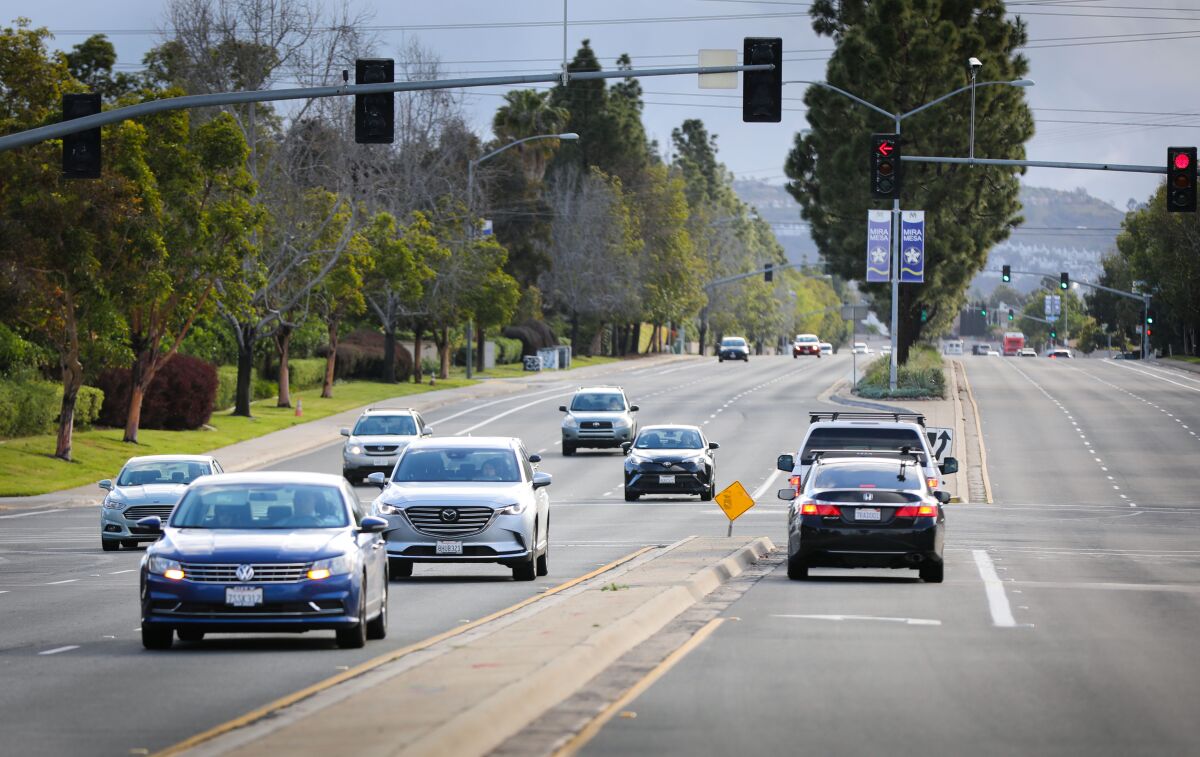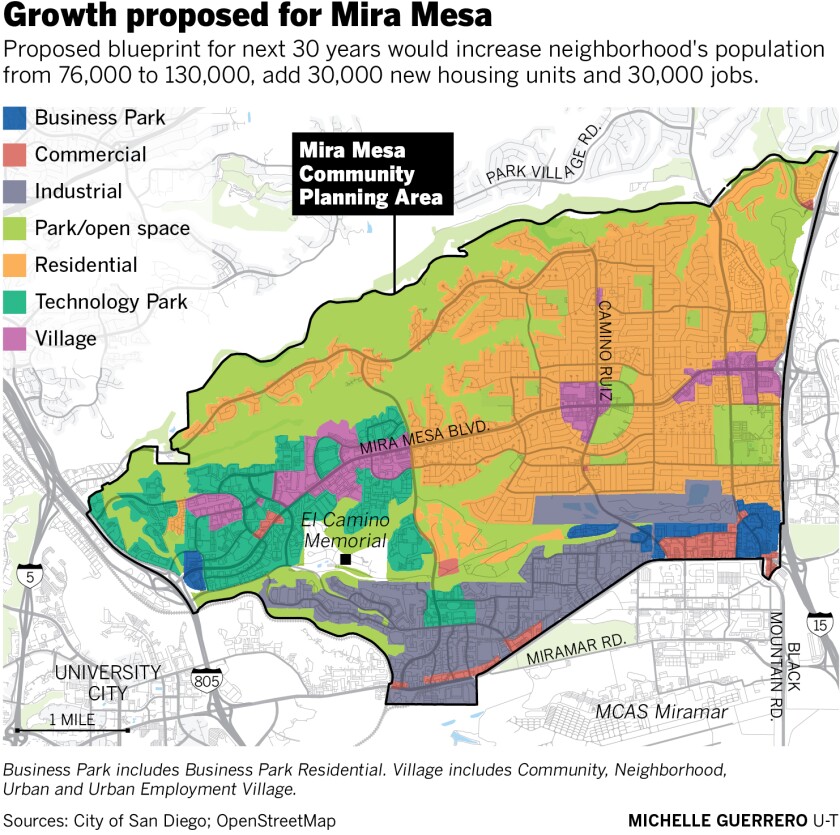Sadly, City Hall insiders seem intent on running roughshod over the biggest neighborhood in our District 6 community instead of addressing its most pressing concerns.
To be clear, I’m OPPOSED to the city’s draft Mira Mesa Community Plan update detailed in this paywall-protected article at the San Diego Union-Tribune website. The city has been proposing different versions of this since 2020 without including a “none of the above” option. If elected, I will put the brakes on this proposal and bring local stakeholders to the table and into the discussion – not City Hall insiders – and send this back to the drawing board so our community is truly able to build an effective, tangible planning document for the next 30 years.
What I’ve shared here is a repost of a David Garrick story in the August 7th on-line edition of the San Diego Union-Tribune. This is NOT original campaign content. Since the changes have such a considerable impact on our District 6 community, our campaign has made the paywall-protected piece available here. – Tommy
“Urban Villages,” an Aerial Skyway and 50,000 More People: Is This the Future of Mira Mesa?
With its new growth blueprint, the city proposes major changes to a community built when strip malls and suburban office parks were king.
By David Garrick
SAN DIEGO — San Diego officials recently unveiled a proposal to transform Mira Mesa from a car-dependent neighborhood dominated by suburban strip malls into a pedestrian-friendly area featuring mixed-use urban villages, walking bridges over major streets and an aerial skyway.
The proposal would reconfigure some vehicle travel lanes on major roadways into lanes for buses or bikes, break up some car-centric superblocks with new streets, and add new parks and other infrastructure to accommodate a population increase from 76,000 to 130,000.
The 77-page plan, which the City Council is scheduled to consider this fall, would be the first update to Mira Mesa’s community growth blueprint since 1992. It aims to guide development of the ethnically diverse neighborhood during the next 30 years.
Mira Mesa is bordered on the east by Interstate 15, on the west by I-805, on the south by Marine Corps Air Station Miramar and on the north by Los Penasquitos Canyon, Torrey Hills and Carmel Valley.
The plan envisions the number of housing units in Mira Mesa more than doubling from 26,800 to about 58,000. The number of jobs in the area — which is the city’s third largest employment center, behind Kearny Mesa and University City — would climb from 85,000 to 117,000.
The city’s Planning Commission recently praised the plan as a comprehensive and ambitious attempt to transform an area that suffers from being laid out primarily in the 1970s, when strip malls and suburban office parks were considered ideal development.
Annexed to the city in 1958 along with Miramar and land east of Del Mar, Mira Mesa was developed mostly in the 1970s. The population climbed from 1,180 in 1970 to 34,600 by the end of 1977, and most of the land uses seen today were decided back then, city officials said.
“This is a built-out suburban community — we’re never going to get the levels of density we’re going to have in other areas,” said Commissioner Matthew Boomhower. “But it’s adding density in good places. We’re increasing the ability to live, work and play in that community and trying to reduce the amount of inflow and outflow every day.”
Neighborhood leaders have criticized the plan for allowing significant growth without the necessary companion infrastructure, particularly more parks and some new roads.
Many of the community’s roads, particularly Mira Mesa Boulevard, are notorious for traffic congestion. Neighborhood leaders are asking how the community can be expected to absorb more than 60,000 new residents and more than 30,000 new jobs without more roads.
The plan aims to alleviate congestion by increasing the ratio of commuters who choose methods other than private vehicles — primarily public transit, walking and biking — from 10 percent to 29 percent.
The creation of urban villages featuring jobs and housing would also increase the number of people who both live and work in Mira Mesa from just under 8,000 to nearly 30,000. In addition, the number of people who commute into the area would drop from 81,000 to 66,000.
A key factor mitigating future traffic congestion is a planned extension of the San Diego Trolley through North Park, Kearny Mesa and the western edge of Mira Mesa, with a station planned for Sorrento Mesa when the new purple line is complete in 2045.
Mira Mesa’s proposed new growth blueprint also includes an aerial skyway that would connect the trolley’s new UC San Diego extension to Sorrento Valley and then to Mira Mesa’s community core at Camino Ruiz.
City officials said a skyway made more sense than proposing light rail within Mira Mesa because of the community’s steep terrain, canyons and valleys.
Jeff Stevens, chairman of the Mira Mesa Community Planning Group, said the proposed skyway is one of the most appealing parts of the proposal.
“I love the idea,” Stevens said. “There’s a lot of magical thinking in this plan, but that’s one I really like if it actually happens.”
Stevens said he’s particularly frustrated by the proposal’s lack of new roadways, with the notable exception of a Carroll Canyon Road extension that has been planned since long before this proposal was created.
But he said the plan to transform many existing car lanes into lanes for buses or bicycles threatens to make congestion even worse. The proposal would create such “flexible lanes” on Camino Ruiz, Westview Parkway, Mira Mesa Boulevard, Miramar Road, Black Mountain Road and Camino Santa Fe.
“Some of their solutions are worse than the disease,” Stevens said.
City officials acknowledge complaints from community leaders that the plans should include more new parks, but they say there is a scarcity of land available. The plan includes several new pocket parks, linear parks and pedestrian paseos that would be included in the eight urban villages envisioned by the plan.
The plan would create urban villages by transforming existing industrial and commercial plazas into more “human-scaled and pedestrian-oriented” areas with dining, shopping, entertainment and lively public spaces for festivals and farmer’s markets.
The transformation would require retrofitting these areas by breaking up mega-blocks with a network of interconnected streets, private street connections and pedestrian and bicycle pathways, the plan says.
The eight urban villages would be the Mira Mesa Town Center, Mira Mesa Gateway, Plaza Sorrento, Plaza Ruiz, Barnes Canyon Road in Sorrento Mesa, Pacific Heights Boulevard in Sorrento Mesa, Sorrento Mesa Rim and Miramar Gateway.
Stevens said Mira Mesa is also being hurt by a shift in how the city calculates the amount of park land required to support new projects. Under the city’s old formula, Mira Mesa would get 161 acres of park land to accommodate the new population growth envisioned by the plan.
Stevens praised the plan for upgrading several hiking trails in the area. The plan would also boost Mira Mesa’s tree canopy to fight climate change and add a new fire station on Camino Santa Fe.
The community is also slated to get new public parks when construction is finished on two large developments, the 1,800-unit 3 Roots project and the 4,500-unit Stone Creek project. Each project includes new parks and roadways to support new residents.
Stevens said that’s the primary reason the local planning group is simultaneously supporting those projects, but raising concerns about the proposed new growth blueprint.
Another concern is the City Council’s approval this week of a new policy governing how the city spends fees collected from developers. Instead of its decades-long practice of keeping developer fees in 44 separate pots of money and requiring the money be spent in the specific neighborhood where it was collected, the city will now pool the money into one pile and spend it in neighborhoods that most need it.
Critics say the policy shift is unfair to neighborhoods where lots of new high-rise and mid-rise housing will be built in coming years.
Under the old policy, those communities — including Mira Mesa — would have been guaranteed the developer fees needed to build infrastructure, libraries and fire stations to support the new growth. Under the new policy, those communities must hope city officials decide their neighborhood is a priority.
A revised version of Mira Mesa’s new proposed growth blueprint is scheduled to be unveiled next month along with a comprehensive analysis of its potential impacts on traffic and the environment.
The plan is then scheduled for public hearings at the Planning Commission in November and the City Council in December.
Photo by Howard Lipin. Map by Michelle Guerrero. Images and story text are the sole property of the San Diego Union Tribune.


